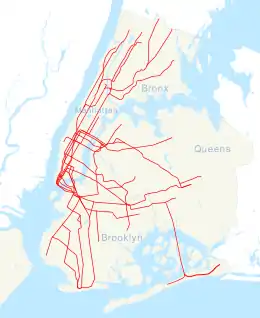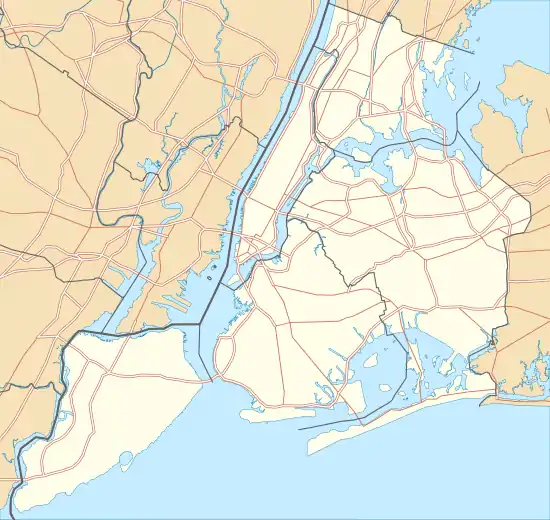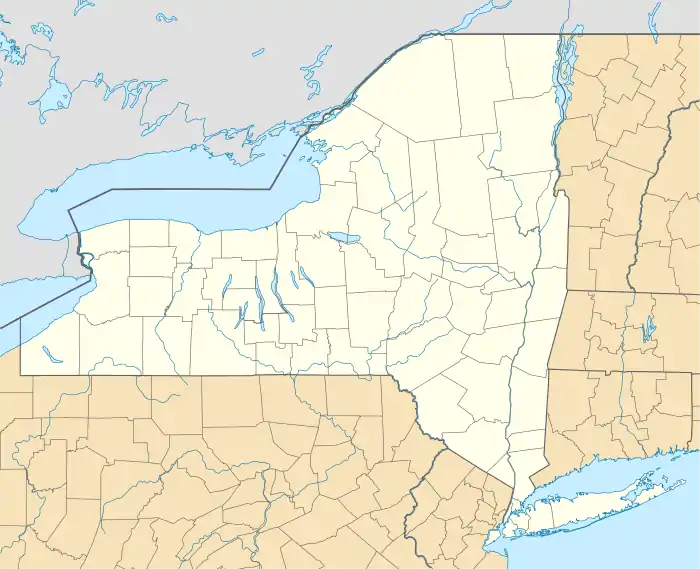Seventh Avenue station (IND lines)
Seventh Avenue is a station on the IND Sixth Avenue Line and the IND Queens Boulevard Line of the New York City Subway. Located at the intersection of Seventh Avenue and 53rd Street in Manhattan, it is served by the D and E trains at all times, and the B train weekdays. The station is announced as Seventh Avenue–53rd Street, in the style of other stations that orient east-west along 53rd Street (such as Fifth Avenue/53rd Street and Lexington Avenue–53rd Street), as well as to prevent confusion with Seventh Avenue along the BMT Brighton Line in Brooklyn, which is also served by the B.
7 Avenue | ||||||||||||||||||||||||||||||||||||||||||||||||||||||||||||||||||||||||||||||||||||||||||||||||||||||||||||||||||||||||||||||||||||||||||||||||||||||||||||||||||
|---|---|---|---|---|---|---|---|---|---|---|---|---|---|---|---|---|---|---|---|---|---|---|---|---|---|---|---|---|---|---|---|---|---|---|---|---|---|---|---|---|---|---|---|---|---|---|---|---|---|---|---|---|---|---|---|---|---|---|---|---|---|---|---|---|---|---|---|---|---|---|---|---|---|---|---|---|---|---|---|---|---|---|---|---|---|---|---|---|---|---|---|---|---|---|---|---|---|---|---|---|---|---|---|---|---|---|---|---|---|---|---|---|---|---|---|---|---|---|---|---|---|---|---|---|---|---|---|---|---|---|---|---|---|---|---|---|---|---|---|---|---|---|---|---|---|---|---|---|---|---|---|---|---|---|---|---|---|---|---|---|---|---|
 Upper Level platform | ||||||||||||||||||||||||||||||||||||||||||||||||||||||||||||||||||||||||||||||||||||||||||||||||||||||||||||||||||||||||||||||||||||||||||||||||||||||||||||||||||
| Station statistics | ||||||||||||||||||||||||||||||||||||||||||||||||||||||||||||||||||||||||||||||||||||||||||||||||||||||||||||||||||||||||||||||||||||||||||||||||||||||||||||||||||
| Address | Seventh Avenue & West 53rd Street New York, NY 10019 | |||||||||||||||||||||||||||||||||||||||||||||||||||||||||||||||||||||||||||||||||||||||||||||||||||||||||||||||||||||||||||||||||||||||||||||||||||||||||||||||||
| Borough | Manhattan | |||||||||||||||||||||||||||||||||||||||||||||||||||||||||||||||||||||||||||||||||||||||||||||||||||||||||||||||||||||||||||||||||||||||||||||||||||||||||||||||||
| Locale | Midtown Manhattan | |||||||||||||||||||||||||||||||||||||||||||||||||||||||||||||||||||||||||||||||||||||||||||||||||||||||||||||||||||||||||||||||||||||||||||||||||||||||||||||||||
| Coordinates | 40.762959°N 73.981891°W | |||||||||||||||||||||||||||||||||||||||||||||||||||||||||||||||||||||||||||||||||||||||||||||||||||||||||||||||||||||||||||||||||||||||||||||||||||||||||||||||||
| Division | B (IND) | |||||||||||||||||||||||||||||||||||||||||||||||||||||||||||||||||||||||||||||||||||||||||||||||||||||||||||||||||||||||||||||||||||||||||||||||||||||||||||||||||
| Line | IND Sixth Avenue Line IND Queens Boulevard Line | |||||||||||||||||||||||||||||||||||||||||||||||||||||||||||||||||||||||||||||||||||||||||||||||||||||||||||||||||||||||||||||||||||||||||||||||||||||||||||||||||
| Services | B D E | |||||||||||||||||||||||||||||||||||||||||||||||||||||||||||||||||||||||||||||||||||||||||||||||||||||||||||||||||||||||||||||||||||||||||||||||||||||||||||||||||
| Transit | ||||||||||||||||||||||||||||||||||||||||||||||||||||||||||||||||||||||||||||||||||||||||||||||||||||||||||||||||||||||||||||||||||||||||||||||||||||||||||||||||||
| Structure | Underground | |||||||||||||||||||||||||||||||||||||||||||||||||||||||||||||||||||||||||||||||||||||||||||||||||||||||||||||||||||||||||||||||||||||||||||||||||||||||||||||||||
| Levels | 2 | |||||||||||||||||||||||||||||||||||||||||||||||||||||||||||||||||||||||||||||||||||||||||||||||||||||||||||||||||||||||||||||||||||||||||||||||||||||||||||||||||
| Platforms | 2 island platforms (1 on each level) cross-platform interchange | |||||||||||||||||||||||||||||||||||||||||||||||||||||||||||||||||||||||||||||||||||||||||||||||||||||||||||||||||||||||||||||||||||||||||||||||||||||||||||||||||
| Tracks | 4 (2 on each level) | |||||||||||||||||||||||||||||||||||||||||||||||||||||||||||||||||||||||||||||||||||||||||||||||||||||||||||||||||||||||||||||||||||||||||||||||||||||||||||||||||
| Other information | ||||||||||||||||||||||||||||||||||||||||||||||||||||||||||||||||||||||||||||||||||||||||||||||||||||||||||||||||||||||||||||||||||||||||||||||||||||||||||||||||||
| Opened | August 19, 1933 | |||||||||||||||||||||||||||||||||||||||||||||||||||||||||||||||||||||||||||||||||||||||||||||||||||||||||||||||||||||||||||||||||||||||||||||||||||||||||||||||||
| Station code | 277[1] | |||||||||||||||||||||||||||||||||||||||||||||||||||||||||||||||||||||||||||||||||||||||||||||||||||||||||||||||||||||||||||||||||||||||||||||||||||||||||||||||||
| Accessible | not ADA-accessible; accessibility planned | |||||||||||||||||||||||||||||||||||||||||||||||||||||||||||||||||||||||||||||||||||||||||||||||||||||||||||||||||||||||||||||||||||||||||||||||||||||||||||||||||
| Accessibility | Cross-platform wheelchair transfer available | |||||||||||||||||||||||||||||||||||||||||||||||||||||||||||||||||||||||||||||||||||||||||||||||||||||||||||||||||||||||||||||||||||||||||||||||||||||||||||||||||
| Opposite- direction transfer | Yes | |||||||||||||||||||||||||||||||||||||||||||||||||||||||||||||||||||||||||||||||||||||||||||||||||||||||||||||||||||||||||||||||||||||||||||||||||||||||||||||||||
| Former/other names | Seventh Avenue–53rd Street | |||||||||||||||||||||||||||||||||||||||||||||||||||||||||||||||||||||||||||||||||||||||||||||||||||||||||||||||||||||||||||||||||||||||||||||||||||||||||||||||||
| Traffic | ||||||||||||||||||||||||||||||||||||||||||||||||||||||||||||||||||||||||||||||||||||||||||||||||||||||||||||||||||||||||||||||||||||||||||||||||||||||||||||||||||
| 2019 | 5,508,778[2] | |||||||||||||||||||||||||||||||||||||||||||||||||||||||||||||||||||||||||||||||||||||||||||||||||||||||||||||||||||||||||||||||||||||||||||||||||||||||||||||||||
| Rank | 80 out of 424[2] | |||||||||||||||||||||||||||||||||||||||||||||||||||||||||||||||||||||||||||||||||||||||||||||||||||||||||||||||||||||||||||||||||||||||||||||||||||||||||||||||||
| Station succession | ||||||||||||||||||||||||||||||||||||||||||||||||||||||||||||||||||||||||||||||||||||||||||||||||||||||||||||||||||||||||||||||||||||||||||||||||||||||||||||||||||
| Next east | ↑ Fifth Avenue/53rd Street (Queens Blvd): E ↓ 47th–50th Streets–Rockefeller Center (6th Ave): B | |||||||||||||||||||||||||||||||||||||||||||||||||||||||||||||||||||||||||||||||||||||||||||||||||||||||||||||||||||||||||||||||||||||||||||||||||||||||||||||||||
| Next west | ↑ 59th Street–Columbus Circle (6th Ave): B ↓ 50th Street (Queens Blvd): E | |||||||||||||||||||||||||||||||||||||||||||||||||||||||||||||||||||||||||||||||||||||||||||||||||||||||||||||||||||||||||||||||||||||||||||||||||||||||||||||||||
| ||||||||||||||||||||||||||||||||||||||||||||||||||||||||||||||||||||||||||||||||||||||||||||||||||||||||||||||||||||||||||||||||||||||||||||||||||||||||||||||||||
| ||||||||||||||||||||||||||||||||||||||||||||||||||||||||||||||||||||||||||||||||||||||||||||||||||||||||||||||||||||||||||||||||||||||||||||||||||||||||||||||||||
| ||||||||||||||||||||||||||||||||||||||||||||||||||||||||||||||||||||||||||||||||||||||||||||||||||||||||||||||||||||||||||||||||||||||||||||||||||||||||||||||||||
| ||||||||||||||||||||||||||||||||||||||||||||||||||||||||||||||||||||||||||||||||||||||||||||||||||||||||||||||||||||||||||||||||||||||||||||||||||||||||||||||||||
History
The Seventh Avenue station was designed as an interchange point between service of the IND Queens Boulevard Line and the IND Sixth Avenue Line. The northern half of the station opened on August 19, 1933 with the opening of the IND Queens Boulevard Line to Roosevelt Avenue in Queens.[3] The southern half of the station opened on December 15, 1940 with the opening of the IND Sixth Avenue Line north of West Fourth Street to 59th Street–Columbus Circle.[4]
In 1990, Utah tourist Brian Watkins was killed at the Seventh Avenue station while trying to protect his family from a robbery.[5] The murder was described as "probably the tipping point in New York’s history of violence and mayhem",[6] marking a low point in the record murder year of 1990 and leading to an increased police presence in New York.[7] Eight people were indicted:[8] the first trial found four of the eight defendants guilty of murder,[9] and a second trial found three of the remaining four defendants to also be guilty.[10] One defendant was later cleared of murder charges.[11]
In 2019, the Metropolitan Transportation Authority announced that the station would become ADA-accessible as part of the agency's 2020–2024 Capital Program.[12] The announcement occurred after a Connecticut woman fell down a staircase trying to carry her 1-year-old daughter on a stroller down a flight of stairs; the baby survived the fall, but the mother died.[13][14]
Station layout
| G | Street level | Exit/entrance |
| M | Mezzanine | Fare control, station agent, MetroCard machines |
| B2 | Southbound | ← |
| Island platform | ||
| Southbound | | |
| B3 | Northbound | |
| Island platform | ||
| Northbound | ← ← | |

This is a two-level station, with two tracks on each level and two island platforms, one over the other. The lower level serves trains headed railroad north (to Central Park West for trains from the IND Sixth Avenue Line, to Queens for trains from the IND Eighth Avenue Line). The upper level is the reverse. Each level allows cross-platform interchange between the two lines.[15] The BMT Broadway Line passes overhead near the west end of the station; this crossing is visible in the ceiling and supporting columns.
The station serves two distinct subway lines that do not interconnect. On the IND Sixth Avenue Line, uptown trains (heading west through the station) join the IND Eighth Avenue Line headed uptown along Central Park West, while downtown trains (heading east through the station) head downtown along the IND Sixth Avenue Line. On the IND Queens Boulevard Line, uptown trains (heading east through the station) go to Queens via the 53rd Street Tunnel, while downtown trains (headed west through the station) head downtown along Eighth Avenue. Although connections would appear to exist on the subway map (because the map shows all levels of tracks in the same plane), there are no connecting tracks. This means that a downtown Sixth Avenue train coming from Central Park West cannot continue to Queens, and an uptown Sixth Avenue train cannot turn downtown along Eighth Avenue, or vice versa.[15]
Exits
This station has two main exits: one at the westbound end of the station at Broadway, and one in the middle of the station at Broadway. The westbound exit has staircases leading to the northeast and southeast corners of 53rd Street and Broadway. The middle exit has staircases leading to the northeast and southeast corners of 53rd Street and Seventh Avenue.[16]
References
- "Station Developers' Information". Metropolitan Transportation Authority. Retrieved June 13, 2017.
- "Facts and Figures: Annual Subway Ridership 2014–2019". Metropolitan Transportation Authority. 2020. Retrieved May 26, 2020.
-
- "TWO SUBWAY UNITS OPEN AT MIDNIGHT; Links in City-Owned System in Queens and Brooklyn to Have 15 Stations" (PDF). The New York Times. August 18, 1933. Retrieved November 7, 2015.
- "New Queens Subway Service Will Be Launched Tonight; Tunnel From Manhattan Open to Jackson Heights; Service Will Eventually Be Extended Through To Jamaica" (PDF). Long Island Daily Press. Fultonhistory.com. August 18, 1933. p. 20. Retrieved July 27, 2016.
- "New Queens Tube To Open Saturday: Brooklyn-Long Island City Link of City Line Also to Be Put in Operation" (PDF). New York Evening Post. Fultonhistory.com. August 17, 1933. p. 18. Retrieved July 27, 2016.
- "New Subway Line on 6th Ave. Opens at Midnight Fete". The New York Times. December 15, 1940. p. 1. Retrieved October 7, 2011.
- Curry, Jack (September 4, 1990). "Tourist Slain In a Subway In Manhattan". The New York Times. ISSN 0362-4331. Retrieved April 16, 2020.
- Hughes, Bill (October 26, 2010). "The Murder That Changed New York City". City Limits. Retrieved April 16, 2020.
- "Last Charges Dismissed in Tourist's Slaying". The New York Times. July 24, 1992. ISSN 0362-4331. Retrieved April 16, 2020.
- Sullivan, Ronald (September 8, 1990). "8 Are Indicted In Slaying Of Tourist". The New York Times. ISSN 0362-4331. Retrieved April 16, 2020.
- "Jury Selection to Begin in 2d Watkins Trial". The New York Times. March 7, 1992. ISSN 0362-4331. Retrieved April 16, 2020.
- "Last Charges Dismissed in Tourist's Slaying". The New York Times. July 24, 1992. ISSN 0362-4331. Retrieved April 16, 2020.
- Rojas, Rick (January 25, 2017). "No Retrial for Man Convicted, Then Cleared, in '90 Subway Killing". The New York Times. ISSN 0362-4331. Retrieved April 16, 2020.
- "Press Release - MTA Headquarters - MTA Announces 20 Additional Subway Stations to Receive Accessibility Improvements Under Proposed 2020-2024 Capital Plan". MTA. December 19, 2019. Retrieved December 24, 2019.
- "Mom dies falling down stairs at NYC subway station as officials seek better accessibility". USA TODAY. January 30, 2019. Retrieved January 1, 2019.
- "A Mother's Fatal Fall on Subway Stairs Rouses New Yorkers to Demand Accessibility". The New York Times. January 29, 2019. Retrieved January 1, 2019.
- Dougherty, Peter (2006) [2002]. Tracks of the New York City Subway 2006 (3rd ed.). Dougherty. OCLC 49777633 – via Google Books.
- "MTA Neighborhood Maps: Midtown West" (PDF). mta.info. Metropolitan Transportation Authority. 2015. Retrieved December 11, 2015.
External links
| Wikimedia Commons has media related to 7th Avenue (IND Queens Boulevard Line). |
- nycsubway.org – IND Queens Boulevard Line: 7th Avenue/53rd Street
- Station Reporter — B Train
- Station Reporter — D Train
- Station Reporter — E Train
- Seventh Avenue entrance from Google Maps Street View
- Broadway entrance from Google Maps Street View
- Upper platform from Google Maps Street View



